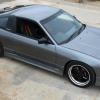More Digital Photography Tips - Post Processing
Announcements
-
Similar Content
-
Latest Posts
-
I purchased some (used but new to me) Yokohama A050 Mediums to try out for the first time and fitted them up to one of my sets of Rays TE Fortesst's. Sizes are 235/45R17 front and 255/40R17 rear. They are very chonky compared to the same sized AD09 on the same sized rim. Some fiddling will be needed to make them fit. How much camber do these like as a general rule? I imagine more than the rear camber of -1.5' I typically run. So my plan is to target -3.8 front and -2 rear







Recommended Posts
Create an account or sign in to comment
You need to be a member in order to leave a comment
Create an account
Sign up for a new account in our community. It's easy!
Register a new accountSign in
Already have an account? Sign in here.
Sign In Now